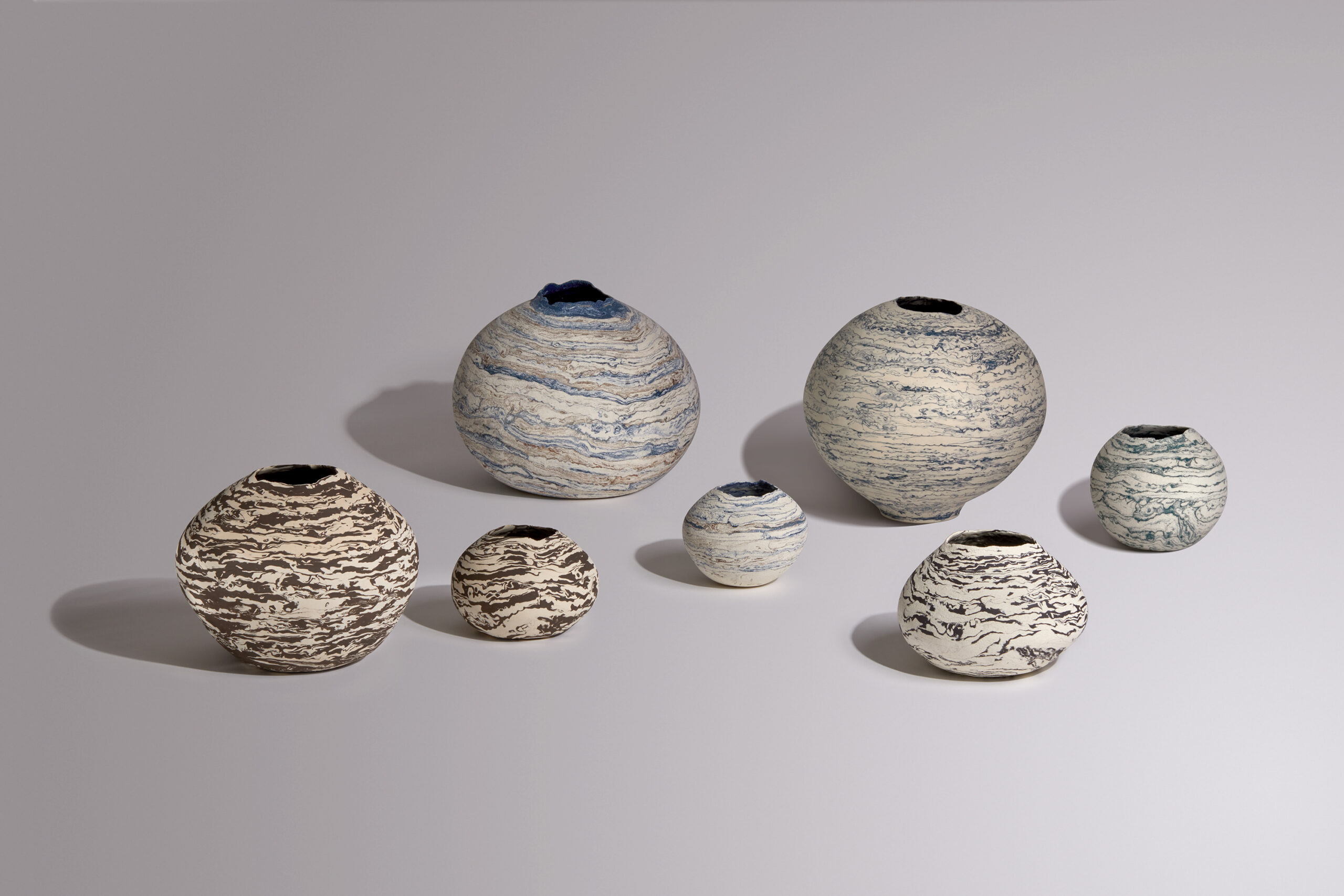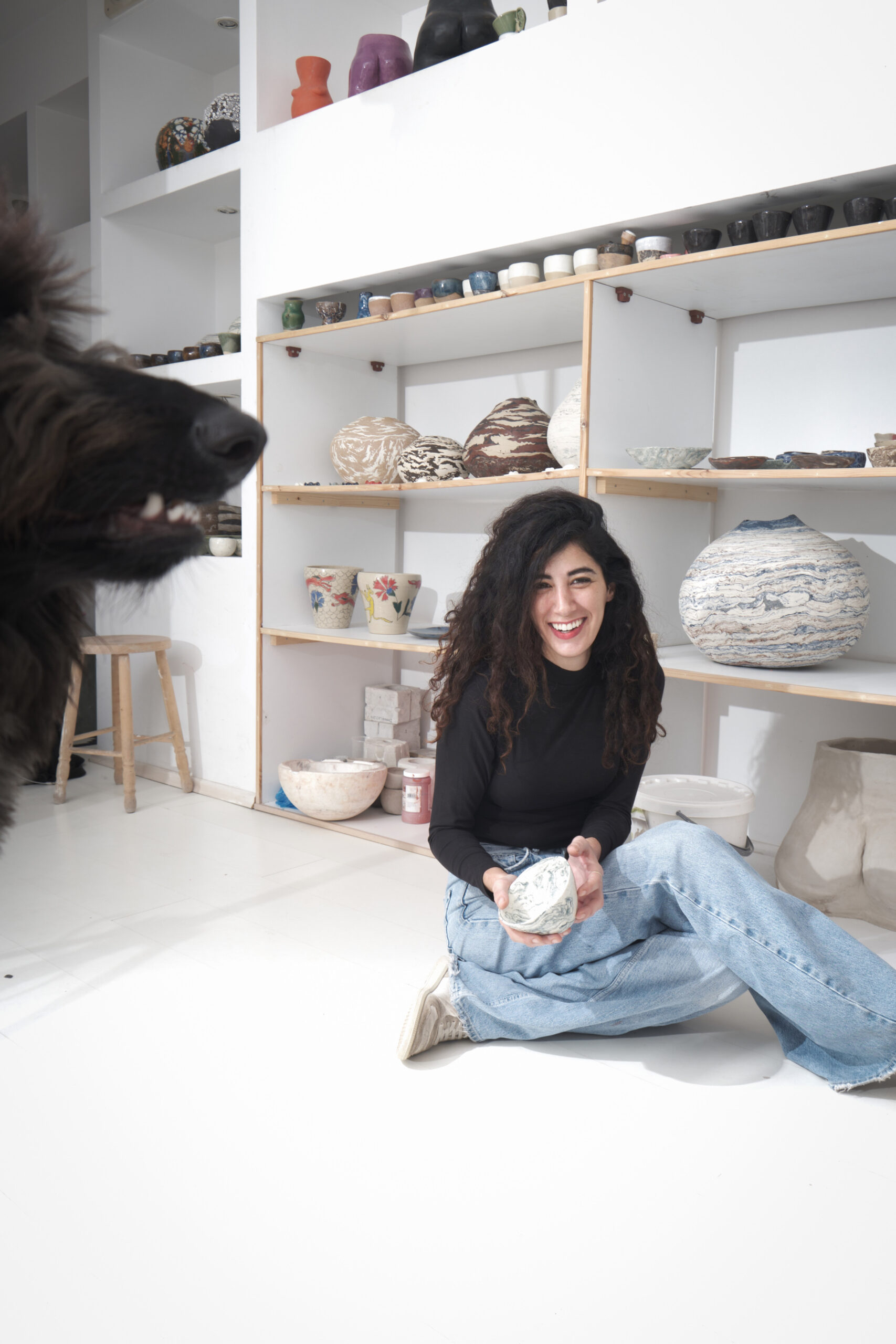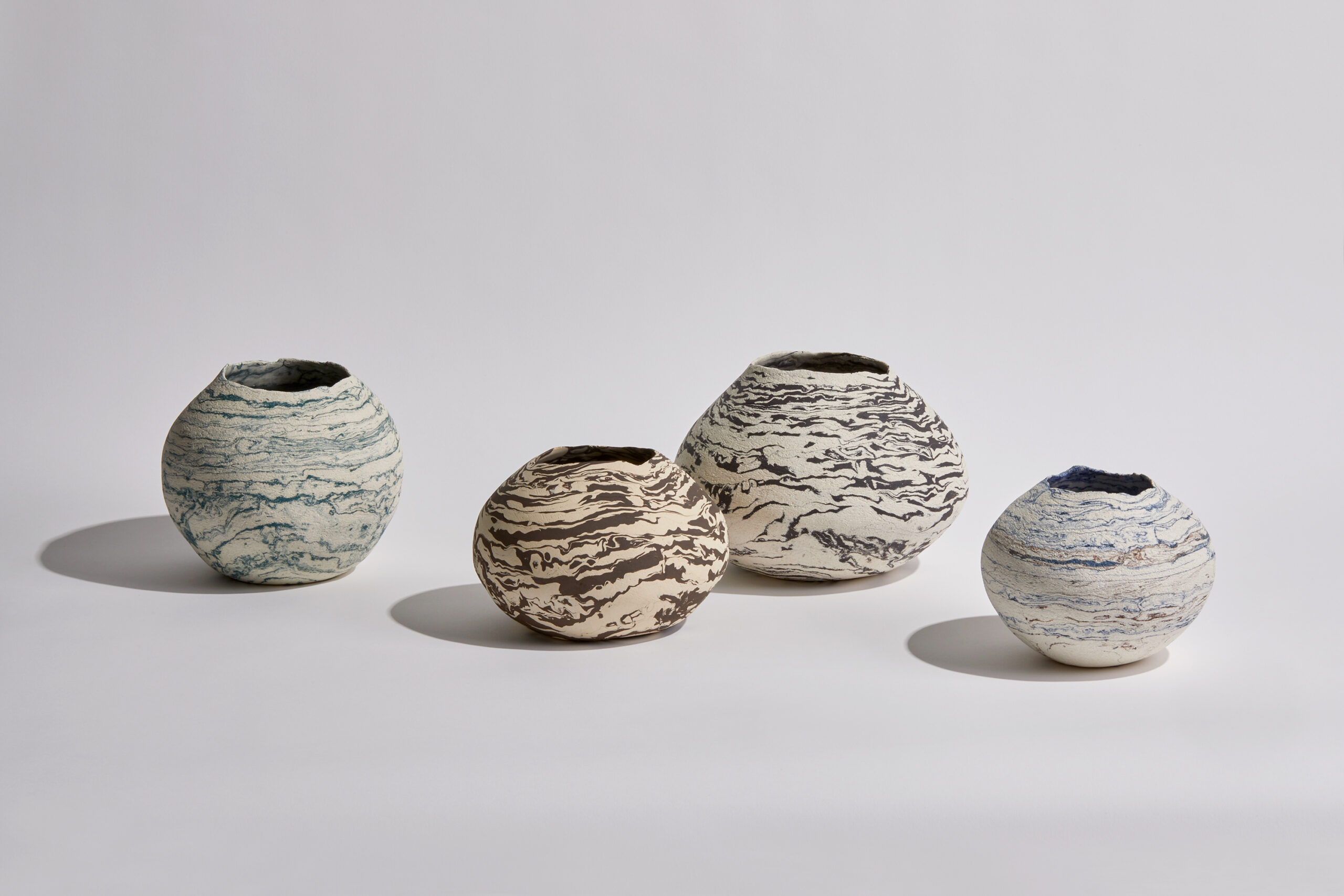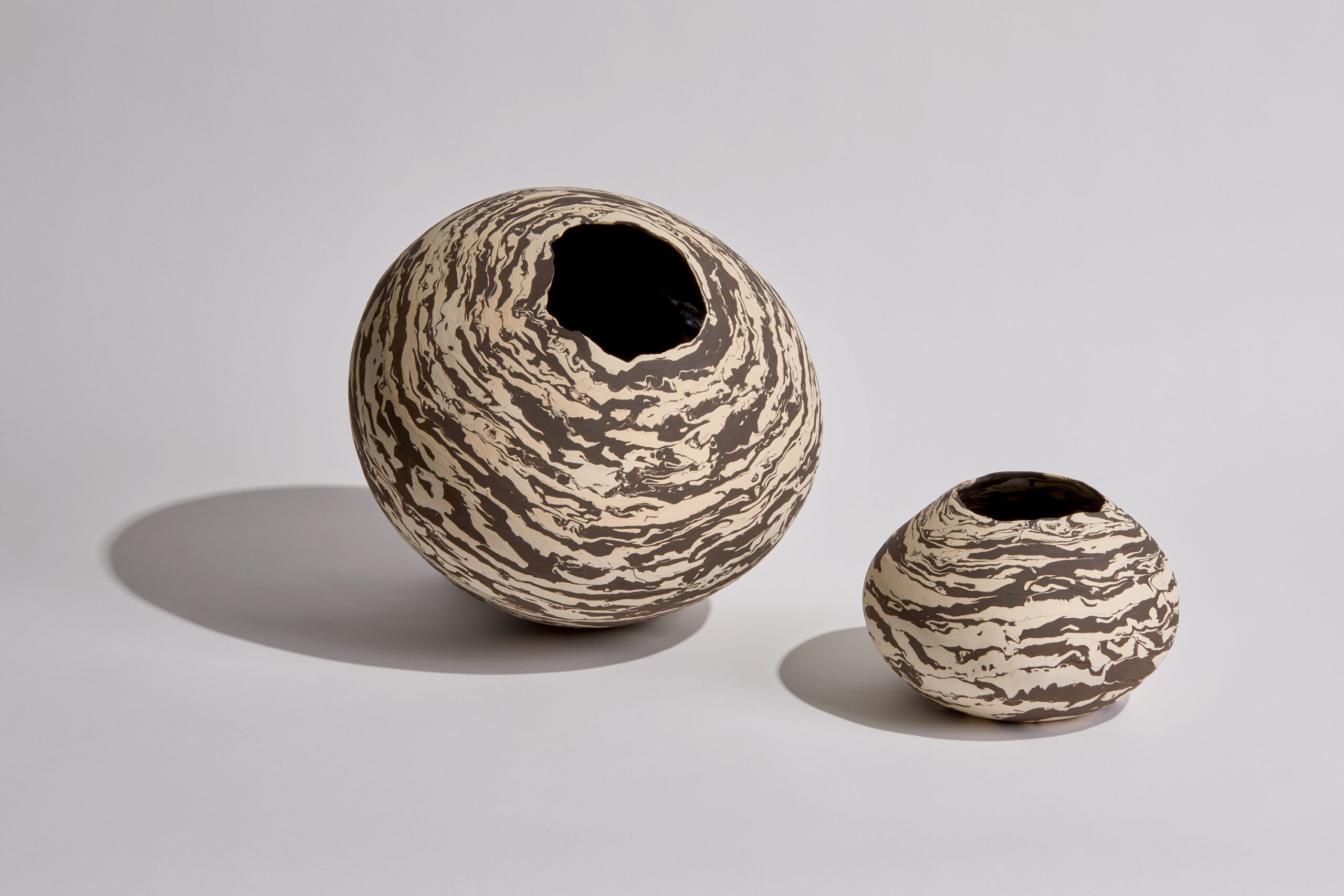Maria Economides
Primal Desires
2 Dec – 16 Feb 2024
Opening: 2 December, 18h – 21h
“Pottery is a continuous curiosity. How it is made, the way it feels, its shape and surface, how the ceramic object exists within a home. When I work with clay, I feel that I enter in a dialogue with the material. I entered into a relationship with it. Clay sets its limits and shows me what it likes and what it doesn’t. Then, I try to make this work for me.”
Maria Economides
About the project
La Boulangerie! is pleased to announce the first solo exhibition in Paris of Greek ceramic artist Maria Economides. The exhibition Primal Desires unveils Economides’ new body of work inspired by nature and her signature series ‘the Body Parts’.
Embark on a captivating journey through the annals of art history with our upcoming exhibition that delves into the earliest and most primitive sculptural expressions of humanity. Drawing inspiration from the timeless allure of the female form, reminiscent of the pivotal Venus of Willendorf, and the evolution of round, sphere-like vessels, Primal Desires encapsulates the essence of human creativity.
Clay, a fundamental medium in the trajectory of artistic evolution, takes centre stage in this exhibition, seamlessly weaving together body parts, spheres, vessels, and the primal nature of clay itself. Economides celebrates her artistic expression, exploring the interconnectedness of these elements. Diving deeper into the intricacies of human nature, we draw parallels between art and the eight primal needs ingrained in our subconscious DNA. From the pursuit of acceptance and connectedness to the yearning for contentment, freedom, gratification, guardianship, prestige, and survival, this is a display that reflects the benevolent facets of these primal desires.
These desires speak of continuity, togetherness, pride of achievement, purpose, and freedom of expression. In a world plagued by wars and destruction, this exhibition serves as a poignant reminder of the inherent goodness within human nature. With a focus on just two elements—spheres and the female body—Primal Desires spans vast epochs of art narrative and human nature.
Join us at La Boulangerie! as we illuminate the profound connection between art and the noble aspirations embedded in the core of our being.

About
Maria Economides
Maria Economides (b. 1980, Thessaloniki Greece) studied business administration to run her family business of timber trade, but arts and crafts was always part of her life. in 2010 she moved with her family in Shanghai, China where she lived for 8 years, having the opportunity to travel all over Asia and discover different cultures. She moved to Athens in 2018 and started studying ceramics that became her passion, because in contrast to this era of instant gratification we are in, clay needs time, patience and concentration.
“Pottery is a continuous curiosity. How it is made, the way it feels, its shape and surface, how the ceramic object exists within a home. When I work with clay, I feel that I enter in a dialogue with the material. I entered into a relationship with it. Clay sets its limits and shows me what it likes and what it doesn’t. Then, I try to make this work for me.”
Economides found inspiration for her collection ‘Body Parts’ in the anatomical votive offerings from the ancient times to now. Archaeologists have recovered at the healing shrines thousands of anatomical votive reliefs; these artifacts were dedicated by grateful patients for the healing of the body part which they received at the god’s sanctuary. In Greece, votive replicas of body parts have been found at the various Asclepian healing centers and other divine cult places. Her forms interplay between the functional and the sculptural with a dose of humour. All her ceramics are handcrafted, using only the simplest of tools.
In the past years, Economides has had a series of international projects, notably and the Van Gogh Foundation in Arles (2023 and ongoing), the Musée des Arts Décoratifs in Paris for the Elsa Schiaparelli exhibition(2022) and the Museum of Ancient Technology in Athens (2021). She has participated at a multitude of group shows, more recently in London with rossogranada and the Invisible Collection for the ‘Resilient Clay’ exhibition under the official programme of the London Craft Week (2023) and the Art Athina fair (2022). She first appeared in the ceramics international scene at the Milan Design Week (2021).
‘Primal Desires’ is Economides’ first solo exhibition in France.

Maria Economides
Primal Desires
2 Dec – 16 Feb 2024
Opening: 2 December, 18h – 21h

“Pottery is a continuous curiosity. How it is made, the way it feels, its shape and surface, how the ceramic object exists within a home. When I work with clay, I feel that I enter in a dialogue with the material. I entered into a relationship with it. Clay sets its limits and shows me what it likes and what it doesn’t. Then, I try to make this work for me.”
Maria Economides
About the project
La Boulangerie! is pleased to announce the first solo exhibition in Paris of Greek ceramic artist Maria Economides. The exhibition Primal Desires unveils Economides’ new body of work inspired by nature and her signature series ‘the Body Parts’.
Embark on a captivating journey through the annals of art history with our upcoming exhibition that delves into the earliest and most primitive sculptural expressions of humanity. Drawing inspiration from the timeless allure of the female form, reminiscent of the pivotal Venus of Willendorf, and the evolution of round, sphere-like vessels, Primal Desires encapsulates the essence of human creativity.
Clay, a fundamental medium in the trajectory of artistic evolution, takes centre stage in this exhibition, seamlessly weaving together body parts, spheres, vessels, and the primal nature of clay itself. Economides celebrates her artistic expression, exploring the interconnectedness of these elements. Diving deeper into the intricacies of human nature, we draw parallels between art and the eight primal needs ingrained in our subconscious DNA. From the pursuit of acceptance and connectedness to the yearning for contentment, freedom, gratification, guardianship, prestige, and survival, this is a display that reflects the benevolent facets of these primal desires.
These desires speak of continuity, togetherness, pride of achievement, purpose, and freedom of expression. In a world plagued by wars and destruction, this exhibition serves as a poignant reminder of the inherent goodness within human nature. With a focus on just two elements—spheres and the female body—Primal Desires spans vast epochs of art narrative and human nature.
Join us at La Boulangerie! as we illuminate the profound connection between art and the noble aspirations embedded in the core of our being.

Available works
Ocean, 2023
cobalt and iron oxides
H45cm x Ø 45cm
Moss, 2023
chromium oxide
H20cm x Ø 20cm
Petite Terre, 2023
stoneware mixed clay
H20cm x Ø 25cm
Woman IV, 2023
Stoneware mixed clay
H 70 cm W 35cm
Ciel, 2023
cobalt oxide
H50cm x Ø 45cm
Marble, 2023
stoneware mixed clay
H20cm x Ø 25cm
Woman II, 2023
stoneware mixed clay
H 60 cm W 35cm
Woman I, 2023
Stoneware mixed clay
H 60 cm W 35cm
Terre, 2023
stoneware mixed clay
H30cm x Ø 35cm
Rivers, 2023
cobalt and iron oxide
H20cm x Ø 20cm
Woman III, 2023
iron and chromium oxide
H 70 cm W 35cm
Exclusive interview
La Boulangerie! in conversation with Maria Economides
Meet Maria Economides, whose work we are currently showing at our space!
LB: You have emerged from a new scene of ceramicists in Greece. Is heritage always part of the dialogue you have with clay when you make your work?
ME: When I’m creating with clay, I feel this incredible tie to Greece’s heritage. The art of pottery here has roots that go way, way back. So, when I’m working, I’m not just shaping clay; I’m kind of having a conversation with history. I take inspiration from the old-school techniques, the traditional patterns, and even the vibes of how they used to do things back in the day. It’s like I’m bringing the past into the present through my ceramics, giving them this deep connection to Greece’s artistic legacy.
LB: With Primal Desires you introduce a new style and language. What is your aim and ambition for your spheres?
ME: So, starting with these ceramic spheres is like going back to the basics, you know? It’s all about rediscovering the very essence of form. I see these spheres as the OG shape, the purest form to work with. But here’s the cool part—I’m not stopping there. Nope, I’m using these spheres as a launchpad for something bigger.
I’ve got this project brewing in my mind where I take these spheres and then shape and mold them into something new for every collection I create down the line. It’s like giving birth to a whole series of transformations, where each collection is like a different stage in the life of this sphere. They’ll grow, change, and become something totally unique with each iteration. This idea is my way of showing how one simple thing can evolve into something incredibly diverse and intricate over time, kind of like a story unfolding right in front of your eyes.
LB: Let’s talk ceramics and sustainability. Is clay making as innocent and romantic as people think? Which artist inspired you? (if you have a French one, do mention.)
ME: Toshiko Takaezu’s work has been a significant source of inspiration for me. Her mastery of form and texture, particularly in her closed-form vessels, resonates deeply with my exploration of primal forms like the sphere. Her dedication to pushing the boundaries of ceramic art has influenced my ambition to evolve and reshape foundational shapes into new and diverse forms.
Moreover, countless women ceramic artists, like Takaezu, have tirelessly contributed to the realm of ceramics. From Lucie Rie’s elegant functional pottery to Beatrice Wood’s whimsical yet sophisticated style, each artist brings a unique perspective and a remarkable dedication to their craft. The collective dedication and artistry of these women in ceramics serve as a guiding light, inspiring me to continually explore, innovate, and evolve my own artistic journey within this vibrant and diverse field.
LB: Tell us how a day in your studio is like?
ME: A day in my studio is a whirlwind of creativity and productivity. Each day brings a blend of fulfilling tasks—sometimes I’m working on completing orders for my customers, meticulously crafting pieces tailored to their desires. Other times, I’m diving into the creation of pieces for upcoming exhibitions, channeling my artistic vision into tangible forms that will soon find their place in the art world.
Teaching is also a significant part of my routine. I spend time guiding enthusiasts through the basics of ceramics, sharing my passion, and witnessing the joy sparked by their own creations taking shape.
But that’s not all! I’m also hands-on with the materials, mixing and experimenting to create unique glazes, ensuring each piece gets its own distinct touch. Recycling clay is another essential task—I believe in minimizing waste and making the most of this versatile material.
Certain days are dedicated to firing—the excitement of loading the kiln, anticipating the transformation of raw clay into hardened art is always thrilling. On glazing days, I meticulously apply layers of color and texture to my pieces, each stroke adding depth and character.
Organizing shelves, cleaning up, and maintaining the studio’s orderliness are vital aspects that keep my creative space conducive to inspiration. Despite the hustle and bustle, when I’m in the studio, time simply flies. It’s a place where passion meets purpose, and every moment is dedicated to bringing artistic visions to life.
LB: Favourite and least favourite part in the life of a ceramic artist?
ME: One of the most favorite parts of being a ceramic artist is the creative process itself—the thrill of shaping clay, the freedom to experiment with forms, and the joy of seeing a piece come to life through firing and glazing. It’s a deeply satisfying and immersive experience that allows for endless exploration and artistic expression.
On the flip side, one of the least favorite aspects can be the unpredictability of working with ceramics. Despite meticulous planning, kiln firings or unexpected flaws in the final piece can occur, sometimes resulting in disappointment after investing time and effort into a creation. Additionally, the physical demands of working with clay, such as the repetitive motions and the toll it can take on one’s body, can also be challenging.
LB: You are a fierce advocate of the coil technique and you work without the help of the wheel. Why are you choosing to do so?
ME: I choose to work with the coil technique because, for me, it’s all about getting up close and personal with the clay. I like having that hands-on control, you know? It lets me shape and mold each piece exactly how I envision it. Skipping the wheel? Well, that’s because I’m all about that traditional, hands-on vibe. It’s like connecting with the craft on a deeper level, really feeling the material as I work with it.
Plus, working without the wheel gives me the freedom to explore textures, play with intricate details, and create these cool, organic shapes that might be trickier with a machine. It’s all about me and the clay, doing our thing together. So, yeah, it’s about that hands-on control, the traditional approach, and just getting to connect with my creations in a more personal way.
LB: Let’s talk ceramics and sustainability. Is clay making as innocent and romantic as people think?
ME: While ceramics can evoke a sense of romance and craftsmanship, its environmental impact isn’t always as innocent as perceived. The process involves mining clay, which can lead to habitat destruction, soil degradation, and landscape alterations. Additionally, the firing process consumes significant amounts of energy and releases emissions, contributing to air pollution.
However, there’s a growing movement in ceramics towards sustainability. Some artists focus on using recycled clay, minimizing waste, and employing more eco-friendly firing methods like solar or wood firing. Furthermore, conscious choices in glazes, opting for non-toxic and locally sourced materials, can reduce environmental harm.
While the inherent nature of ceramics may not be entirely innocent from an environmental perspective, there’s a shift towards more sustainable practices within the craft, aiming to mitigate its ecological footprint.
About Maria Economides
Maria Economides (b. 1980, Thessaloniki Greece) studied business administration to run her family business of timber trade, but arts and crafts was always part of her life. in 2010 she moved with her family in Shanghai, China where she lived for 8 years, having the opportunity to travel all over Asia and discover different cultures. She moved to Athens in 2018 and started studying ceramics that became her passion, because in contrast to this era of instant gratification we are in, clay needs time, patience and concentration.
“Pottery is a continuous curiosity. How it is made, the way it feels, its shape and surface, how the ceramic object exists within a home. When I work with clay, I feel that I enter in a dialogue with the material. I entered into a relationship with it. Clay sets its limits and shows me what it likes and what it doesn’t. Then, I try to make this work for me.”
Economides found inspiration for her collection ‘Body Parts’ in the anatomical votive offerings from the ancient times to now. Archaeologists have recovered at the healing shrines thousands of anatomical votive reliefs; these artifacts were dedicated by grateful patients for the healing of the body part which they received at the god’s sanctuary. In Greece, votive replicas of body parts have been found at the various Asclepian healing centers and other divine cult places. Her forms interplay between the functional and the sculptural with a dose of humour. All her ceramics are handcrafted, using only the simplest of tools.
In the past years, Economides has had a series of international projects, notably and the Van Gogh Foundation in Arles (2023 and ongoing), the Musée des Arts Décoratifs in Paris for the Elsa Schiaparelli exhibition(2022) and the Museum of Ancient Technology in Athens (2021). She has participated at a multitude of group shows, more recently in London with rossogranada and the Invisible Collection for the ‘Resilient Clay’ exhibition under the official programme of the London Craft Week (2023) and the Art Athina fair (2022). She first appeared in the ceramics international scene at the Milan Design Week (2021).
‘Primal Desires’ is Economides’ first solo exhibition in France.

Exclusive interview
La Boulangerie! in conversation with
Maria Economides
Meet ceramic artist Maria Economides, whose new body of work we are currently showing at our space!
LB: You have emerged from a new scene of ceramicists in Greece. Is heritage always part of the dialogue you have with clay when you make your work?
ME: When I’m creating with clay, I feel this incredible tie to Greece’s heritage. The art of pottery here has roots that go way, way back. So, when I’m working, I’m not just shaping clay; I’m kind of having a conversation with history. I take inspiration from the old-school techniques, the traditional patterns, and even the vibes of how they used to do things back in the day. It’s like I’m bringing the past into the present through my ceramics, giving them this deep connection to Greece’s artistic legacy.
LB: With Primal Desires you introduce a new style and language. What is your aim and ambition for your spheres?
ME: So, starting with these ceramic spheres is like going back to the basics, you know? It’s all about rediscovering the very essence of form. I see these spheres as the OG shape, the purest form to work with. But here’s the cool part—I’m not stopping there. Nope, I’m using these spheres as a launchpad for something bigger.
I’ve got this project brewing in my mind where I take these spheres and then shape and mold them into something new for every collection I create down the line. It’s like giving birth to a whole series of transformations, where each collection is like a different stage in the life of this sphere. They’ll grow, change, and become something totally unique with each iteration. This idea is my way of showing how one simple thing can evolve into something incredibly diverse and intricate over time, kind of like a story unfolding right in front of your eyes.
LB: Let’s talk ceramics and sustainability. Is clay making as innocent and romantic as people think?LB: Which artists inspire you? (if you have a French one, do mention)
ME: Toshiko Takaezu’s work has been a significant source of inspiration for me. Her mastery of form and texture, particularly in her closed-form vessels, resonates deeply with my exploration of primal forms like the sphere. Her dedication to pushing the boundaries of ceramic art has influenced my ambition to evolve and reshape foundational shapes into new and diverse forms.
Moreover, countless women ceramic artists, like Takaezu, have tirelessly contributed to the realm of ceramics. From Lucie Rie’s elegant functional pottery to Beatrice Wood’s whimsical yet sophisticated style, each artist brings a unique perspective and a remarkable dedication to their craft. The collective dedication and artistry of these women in ceramics serve as a guiding light, inspiring me to continually explore, innovate, and evolve my own artistic journey within this vibrant and diverse field.
LB: Tell us how a day in your studio is like?
ME: A day in my studio is a whirlwind of creativity and productivity. Each day brings a blend of fulfilling tasks—sometimes I’m working on completing orders for my customers, meticulously crafting pieces tailored to their desires. Other times, I’m diving into the creation of pieces for upcoming exhibitions, channeling my artistic vision into tangible forms that will soon find their place in the art world.
Teaching is also a significant part of my routine. I spend time guiding enthusiasts through the basics of ceramics, sharing my passion, and witnessing the joy sparked by their own creations taking shape.
But that’s not all! I’m also hands-on with the materials, mixing and experimenting to create unique glazes, ensuring each piece gets its own distinct touch. Recycling clay is another essential task—I believe in minimizing waste and making the most of this versatile material.
Certain days are dedicated to firing—the excitement of loading the kiln, anticipating the transformation of raw clay into hardened art is always thrilling. On glazing days, I meticulously apply layers of color and texture to my pieces, each stroke adding depth and character.
Organizing shelves, cleaning up, and maintaining the studio’s orderliness are vital aspects that keep my creative space conducive to inspiration. Despite the hustle and bustle, when I’m in the studio, time simply flies. It’s a place where passion meets purpose, and every moment is dedicated to bringing artistic visions to life.
LB: Favourite and least favourite part in the life of a ceramic artist?
ME: One of the most favorite parts of being a ceramic artist is the creative process itself—the thrill of shaping clay, the freedom to experiment with forms, and the joy of seeing a piece come to life through firing and glazing. It’s a deeply satisfying and immersive experience that allows for endless exploration and artistic expression.
On the flip side, one of the least favorite aspects can be the unpredictability of working with ceramics. Despite meticulous planning, kiln firings or unexpected flaws in the final piece can occur, sometimes resulting in disappointment after investing time and effort into a creation. Additionally, the physical demands of working with clay, such as the repetitive motions and the toll it can take on one’s body, can also be challenging.
LB: You are a fierce advocate of the coil technique and you work without the help of the wheel. Why are you choosing to do so?
ME: I choose to work with the coil technique because, for me, it’s all about getting up close and personal with the clay. I like having that hands-on control, you know? It lets me shape and mold each piece exactly how I envision it. Skipping the wheel? Well, that’s because I’m all about that traditional, hands-on vibe. It’s like connecting with the craft on a deeper level, really feeling the material as I work with it.
Plus, working without the wheel gives me the freedom to explore textures, play with intricate details, and create these cool, organic shapes that might be trickier with a machine. It’s all about me and the clay, doing our thing together. So, yeah, it’s about that hands-on control, the traditional approach, and just getting to connect with my creations in a more personal way.
LB: Let’s talk ceramics and sustainability. Is clay making as innocent and romantic as people think?
ME: While ceramics can evoke a sense of romance and craftsmanship, its environmental impact isn’t always as innocent as perceived. The process involves mining clay, which can lead to habitat destruction, soil degradation, and landscape alterations. Additionally, the firing process consumes significant amounts of energy and releases emissions, contributing to air pollution.
However, there’s a growing movement in ceramics towards sustainability. Some artists focus on using recycled clay, minimizing waste, and employing more eco-friendly firing methods like solar or wood firing. Furthermore, conscious choices in glazes, opting for non-toxic and locally sourced materials, can reduce environmental harm.
While the inherent nature of ceramics may not be entirely innocent from an environmental perspective, there’s a shift towards more sustainable practices within the craft, aiming to mitigate its ecological footprint.



















